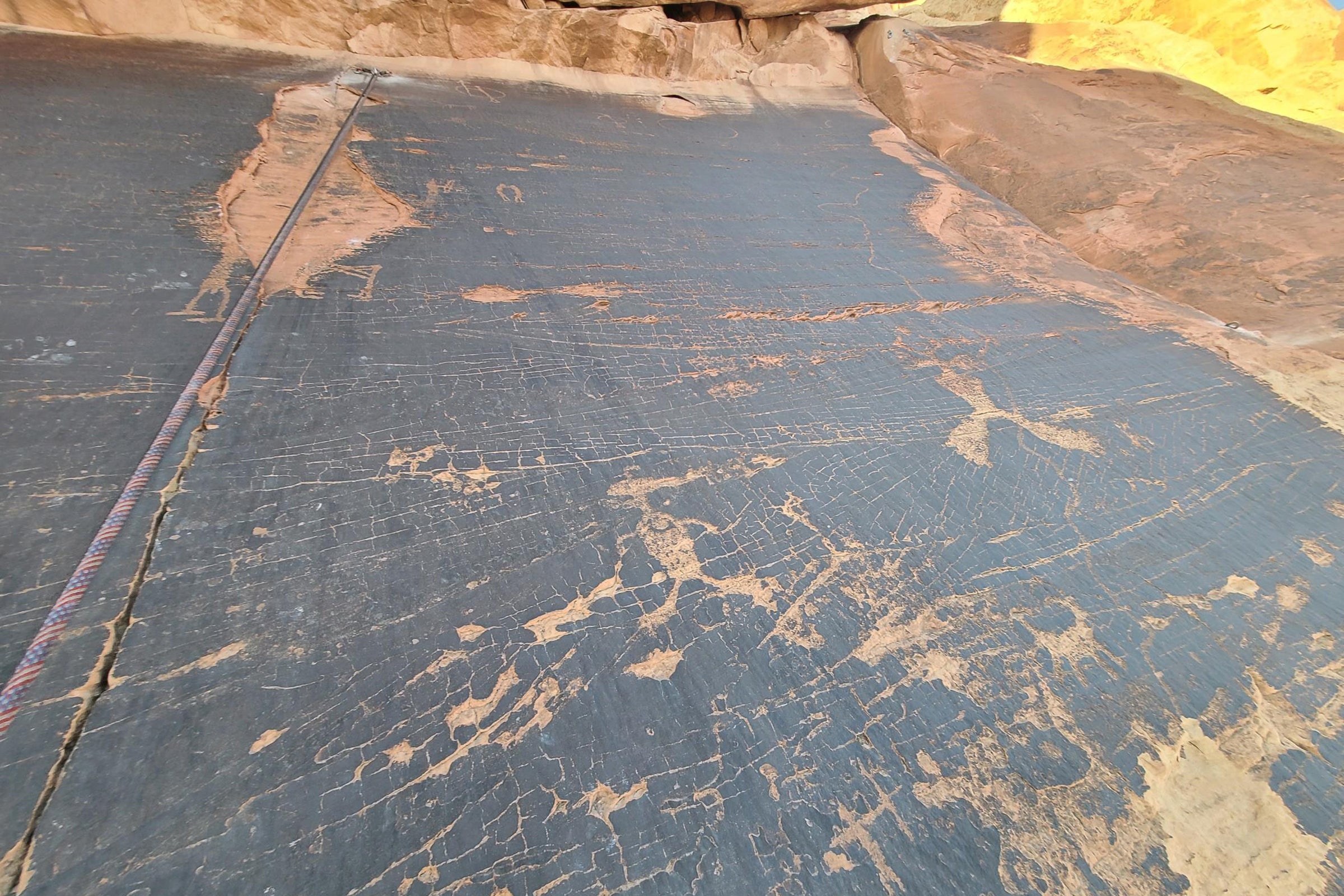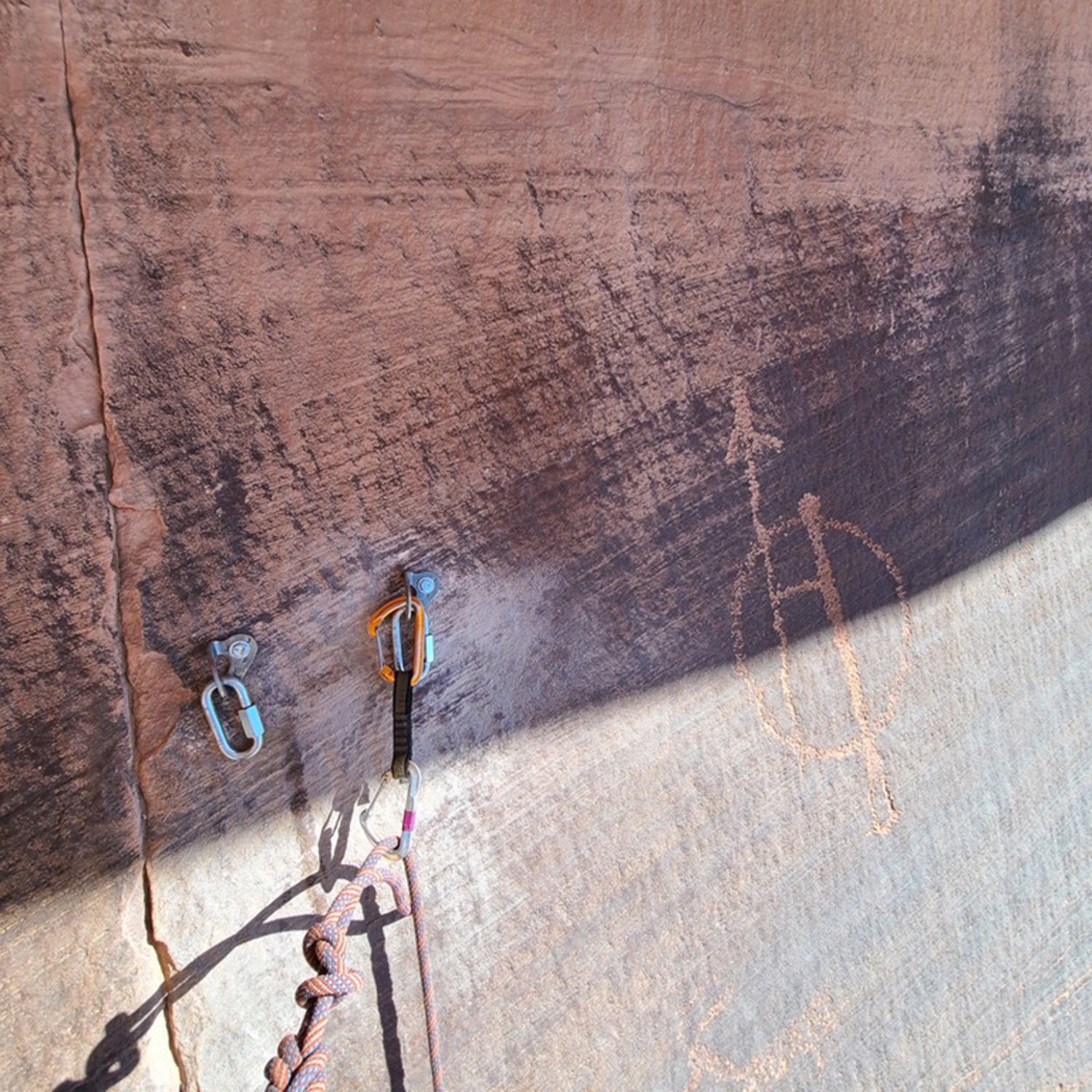On Friday, April 9, climbing guide Darrin Reay and a few friends went to the remote Sunshine Wall Slabs north of UtahŌĆÖs Arches National Park for a weekend of climbing. When they arrived, they came across three newly bolted sport routes.╠²
Reay started up one of the new lines, an easy 5.3. About 30 feet off the ground, though, he came face to face with the image of a warrior holding a spear etched into the agate. Reay realized he was climbing through an entire 20-by-30-foot╠²panel of a few dozen Native petroglyphs.
ŌĆ£The route went straight through the whole thing,ŌĆØ Reay told ║┌┴Ž│į╣Ž═°. After downclimbing and determining that the two nearby routes were also bolted through the petroglyph panel, Reay and his friends spent the weekend removing the bolts and documenting the damage.
ŌĆ£I thought about leaving them up for the sake of reporting them,ŌĆØ Reay told friend and climber Stewart Green, who about the incident on Facebook. ŌĆ£But I just couldnŌĆÖt leave them up. It was my duty.ŌĆØ The petroglyphs, Green thought, appeared to be from the Fremont people, a pre-Columbian Native American culture that inhabited Utah and parts of surrounding states between 2,000 and 700 years ago. ItŌĆÖs unclear whether or not Green is correct, but similar petroglyphs attributed to the Fremont people have been documented in other areas nearby.╠²

It didnŌĆÖt take long to figure out the boltsŌĆÖ origin. Reay and his friends╠²found the routes posted on , a user-generated database of climbing routes, and traced the incident back to Richard Gilbert, a climber from Colorado Springs, Colorado.╠²
Gilbert, a veteran of the Marines and a 15-year climber, has since come out publicly with an apology and a description of his actions, which he insists is ŌĆ£no excuse for the damage done.ŌĆØ╠²
According to Gilbert, in late March he explored the unbolted wall in the Sunshine Slabs area and mistook a number of petroglyphs for graffiti, attributing what he assumed was╠²vandalism to the wallŌĆÖs proximity to a╠²public campground. He╠²decided it would be safe to develop routes up the wall.╠²Later he╠²added information about the new routes to Mountain Project, mentioning what he interpreted as graffiti in the description. (Those routes were eventually removed by an administrator to discourage climbing in the area.) It only took a few weeks for his mistake to catch the attention of the websiteŌĆÖs dedicated community of climbers. Outrage quickly followed.
GilbertŌĆÖs story unfolded largely through conversations on Mountain ProjectŌĆÖs forums, where he says he first realized his error. ŌĆ£On Sunday night, I saw a post on my route [at Sunshine Slabs] and it said, ŌĆśHey, this is not graffiti, these are petroglyphs.ŌĆÖ I was like, Oh my gosh, I completely messed this up, IŌĆÖm going to fix it right now,ŌĆØ he said.╠²He changed╠²the route╠²descriptions╠²on Mountain Project to steer climbers away from the area, drove╠²back to the wall to fill in the bolt holes, and left╠²a sign to draw attention to the petroglyphs.
ŌĆ£ItŌĆÖs wrong. It shouldnŌĆÖt have happened. ItŌĆÖs just poor education on my part, and I do take full responsibility,ŌĆØ Gilbert says.
He returned to the area on Monday, April 12, and met with authorities from the Moab Bureau of Land Management to report the incident in person. ŌĆ£I told him this was my mistake, and asked what do I have to do to make sure other people arenŌĆÖt paying for my mistake,ŌĆØ he said. The BLM office╠²opened an investigation after the╠²meeting and previous calls to report the incident, Gilbert said. (The BLM office did not respond to requests for comment in time for publication.) According to , rock art like this is federally protected, and damaging acts can lead to felony and/or misdemeanor charges, with penalties that can include╠²up to a ten-year prison sentence and $100,000 in fines.
Meanwhile, conversations online about the incident turned to death threats against Gilbert and expressed anger over his actions, including many public posts on Mountain ProjectŌĆÖs forums and direct messages and phone calls to him.
Green posted about the incident on Facebook this week, advocating for more awareness in the climbing community around cultural resources and Leave No Trace policies. ŌĆ£The fact is that we just canŌĆÖt do whatever we want as climbers anymore,ŌĆØ he wrote, ŌĆ£unlike the Wild West days when I was a young climber and anything went.ŌĆØ
Similar situations have played out in popular climbing areas across the United States, including , , and , where routes have been removed and areas near╠²rock-art sites have been closed.
Along with the apology both online and in an , Gilbert has acknowledged the work required to not only repair the physical damage╠²but also the ties with Native communities after the damage. ŌĆ£IŌĆÖm not the victim here,ŌĆØ he said. ŌĆ£I made a mistake, and IŌĆÖll pay for my mistake, but I think itŌĆÖs also important to let the Native individuals have a voice and be heard now.ŌĆØ╠²
Gilbert, Reay, and Green each expressed the importance this incident has had in teaching climbers the history of the sites they climb on╠²and the need to prevent these problems in the future. ŌĆ£I want this to educate people on the outdoors as much as possible,ŌĆØ Reay said. ŌĆ£ItŌĆÖs been a passion of mine for a long time, and I donŌĆÖt want to see these places and our access to public lands jeopardized because of a few peopleŌĆÖs actions.ŌĆØ


